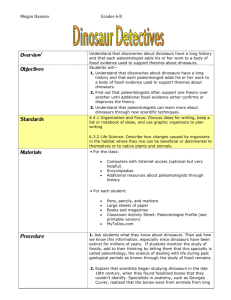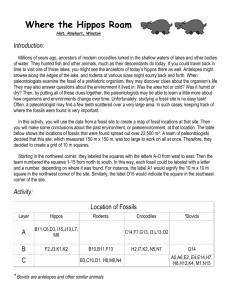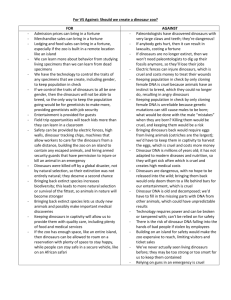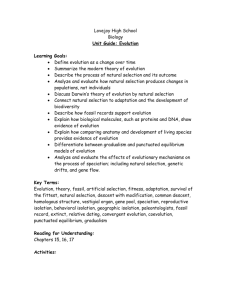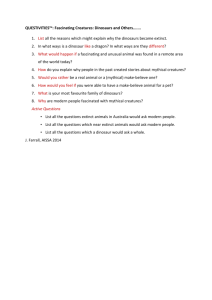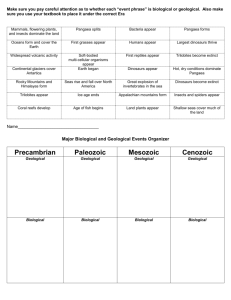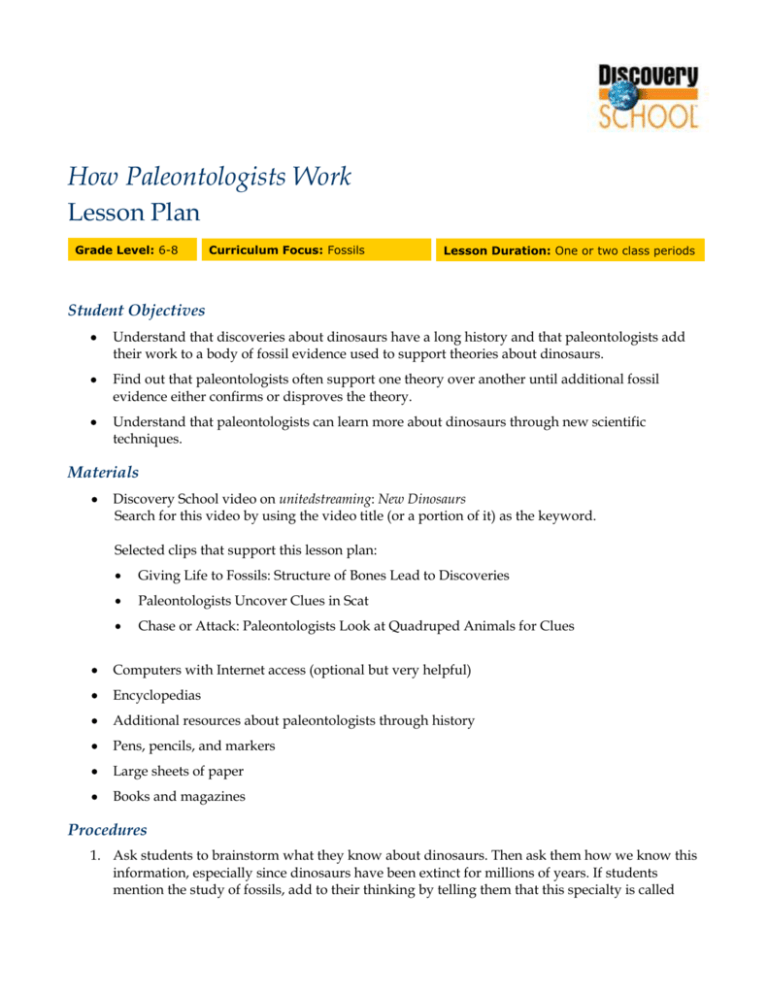
How Paleontologists Work
Lesson Plan
Grade Level: 6-8
Curriculum Focus: Fossils
Lesson Duration: One or two class periods
Student Objectives
Understand that discoveries about dinosaurs have a long history and that paleontologists add
their work to a body of fossil evidence used to support theories about dinosaurs.
Find out that paleontologists often support one theory over another until additional fossil
evidence either confirms or disproves the theory.
Understand that paleontologists can learn more about dinosaurs through new scientific
techniques.
Materials
Discovery School video on unitedstreaming: New Dinosaurs
Search for this video by using the video title (or a portion of it) as the keyword.
Selected clips that support this lesson plan:
Giving Life to Fossils: Structure of Bones Lead to Discoveries
Paleontologists Uncover Clues in Scat
Chase or Attack: Paleontologists Look at Quadruped Animals for Clues
Computers with Internet access (optional but very helpful)
Encyclopedias
Additional resources about paleontologists through history
Pens, pencils, and markers
Large sheets of paper
Books and magazines
Procedures
1. Ask students to brainstorm what they know about dinosaurs. Then ask them how we know this
information, especially since dinosaurs have been extinct for millions of years. If students
mention the study of fossils, add to their thinking by telling them that this specialty is called
How Paleontologists Work
Lesson Plan
2
paleontology, the science dealing with life during past geological periods as known through the
study of fossil remains. (If students are completely unfamiliar with this area of science, simply
explain what the lesson will cover.)
2. Explain that scientists began studying dinosaurs in the late-18th century, when they found
fossilized bones that they could not identify. Georges Cuvier and other specialists in anatomy
realized that the bones belonged to animals from long ago. This led Cuvier to introduce the idea
of extinction. Before that time, people believed that the animals on Earth had always existed
unchanged.
3. Discuss how over time paleontology emerged as a specialty as scientists found enough
fossilized bones to reconstruct entire dinosaur skeletons. By studying these skeletons,
paleontologists have been able to propose theories about the world that existed millions of years
ago.
4. Explain to students that they are going to conduct research about some major paleontologists
and their discoveries. Divide the class into small teams of about 2-3 students. Each group will
research a paleontologist to study in-depth and present an oral report to the class.
5. Following is a list of paleontologists who have made significant discoveries. If students are
familiar with paleontologists, they may want to choose one from this list or from their own
research. If this is a new topic to students, you could assign a paleontologist to each group:
Georges Cuvier (1769-1832)
Gideon Mantell (1790-1852)
Mary Anning (1799-1847)
Othniel Marsh (1831-1899)
Edward Drinker Cope (1840-1897)
Roy C. Andrews (1884-1960)
Roland T. Bird (1899-1978)
Robert Bakker (b. 1945)
James I. Kirkland (b. 1954)
Paul C. Sereno (b. 1958)
6. Have each group complete the Paleontologist Profile (see last page). Point out to students that
advances in technology have given paleontologists new insight into the world of dinosaurs. For
example, with accurate carbon-14 dating, scientists can place the bones correctly in the
geological time span. With CAT-scan technology, they can see inside fossilized dinosaur skulls.
Computers can now create virtual dinosaurs that show scientists how the giant beasts once
moved. The examination of fossilized dinosaur coprolite, or dung, may tell scientists what
dinosaurs ate. Encourage students to include maps of where the fieldwork has taken place and
drawings of the scientists' major discoveries.
7. Suggest that students use the following Web sites as part of their research:
Georges Cuvier
Published by Discovery Education. © 2005. All rights reserved.
How Paleontologists Work
Lesson Plan
3
http://www.ucmp.berkeley.edu/history/cuvier.html
Geological Time Scale
http://www.ZoomSchool.com/subjects/dinosaurs
General sites on paleontologists
http://www.ZoomSchool.com/subjects/dinsoaurs/glossary/Paleontologists/shtml
http://www.dinohunters.com/Hunters/hunter.htm
http://www.dinohunters.com/Hunters/chronology.htm
http://www.lhl.lib.mo.us/pubserv/hos.dino.welcome.htm
Assessment
Use the following three-point rubric to evaluate students’ work during this lesson.
3 points: Students answered the stated questions in the report; gave a logical oral report
using some graphics such as maps or drawings; took notes to use to fill in the timeline
completely.
2 points: Students answered the stated questions in the report; student gave a logical oral
report; student took notes and partially filled in the timeline.
1 point: Students answered most of the stated questions in the report; gave a somewhat
logical oral report; student added some new information to the timeline.
Vocabulary
carbon-14 dating
Definition: A heavy radioactive isotope used to date archaeological and geological materials
Context: Paleontologists have come to depend on carbon-14 dating to determine the age of fossil
remains.
CAT (computer-assisted tomography) scan
Definition: A three-dimensional picture of the internal structures of a solid object made by
integrating an x-ray and a computer image
Context: Paleontologists use CAT scans to investigate the insides of fossils, such as the nasal
passage of a skull.
coprolite (KAH-pruh-lite)
Definition: Fossilized excrement
Context: Thin cross-sections of coprolite examined under a microscope can help determine the
diet of a dinosaur.
fossil
Definition: A remnant, impression, or trace of an organism of past geological ages that has been
preserved in Earth’s crust
Published by Discovery Education. © 2005. All rights reserved.
How Paleontologists Work
Lesson Plan
4
Context: Paleontologists use great care not to damage a dinosaur fossil when they remove it
from the ground.
paleontology (pay-lee-on-TOL-oh-gee)
Definition: The science dealing with the life of past geological periods as known from fossil
records
Context: If you are interested in dinosaurs and fossils of ancient life forms, you may enjoy a
career in paleontology.
Academic Standards
National Academy of Sciences
The National Science Education Standards provide guidelines for teaching science as well as a
coherent vision of what it means to be scientifically literate for students in grades K-12. To view the
standards, visit http://books.nap.edu.
This lesson plan addresses the following science standards:
Life Science: Diversity and adaptations of organisms
Earth Science: Earth’s history
Mid-continent Research for Education and Learning (McREL)
McREL's Content Knowledge: A Compendium of Standards and Benchmarks for K-12 Education
addresses 14 content areas. To view the standards and benchmarks, visit link:
http://www.mcrel.org/compendium/browse.asp
This lesson plan addresses the following national standards:
Science—Life Sciences: Understands biological evolution and the diversity of life
Language Arts—Reading: Uses reading skills and strategies to understand and interpret a
variety of informational texts; Speaking and Listening: Uses listening and speaking
strategies for different purposes
Support Materials
Develop custom worksheets, educational puzzles, online quizzes, and more with the free teaching tools
offered on the Discoveryschool.com Web site. Create and print support materials, or save them to a
Custom Classroom account for future use. To learn more, visit
http://school.discovery.com/teachingtools/teachingtools.html
Published by Discovery Education. © 2005. All rights reserved.
Lesso
n
Plan:
How
Paleo
ntolo
gists
Work
Paleontologist Profile
1. Paleontologist’s name: _____________________________________________________
2. When did (does) he or she live?
3. Where did (does) the paleontologist carry out fieldwork?
4. What are his or her major discoveries?
5. What theories did (or does) he or she support?
6. What technology aided the paleontologist in his or her work?

